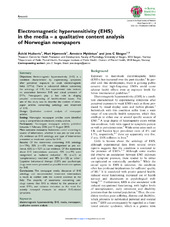| dc.contributor.author | Huiberts, Åshild | |
| dc.contributor.author | Hjørnevik, Mari Karlsen | |
| dc.contributor.author | Mykletun, Arnstein | |
| dc.contributor.author | Skogen, Jens Christoffer | |
| dc.date.accessioned | 2015-09-03T13:05:23Z | |
| dc.date.available | 2015-09-03T13:05:23Z | |
| dc.date.issued | 2013-11 | |
| dc.identifier.issn | 2042-5333 | |
| dc.identifier.issn | 2054-2704 | |
| dc.identifier.uri | https://hdl.handle.net/1956/10392 | |
| dc.description.abstract | Objectives: Electromagnetic hypersensitivity (EHS) is a condition characterized by experiencing symptoms after perceived exposure to weak electromagnetic fields (EMFs). There is substantial debate concerning the aetiology of EHS, but experimental data indicate no association between EHS and actual presence of EMFs. Newspapers play a key role in shaping peoples’ understanding of health-related issues. The aim of this study was to describe the content of newspaper articles concerning aetiology and treatment of EHS. Design: Qualitative content analysis of newspaper articles. Setting: Norwegian newspaper articles were identified using a comprehensive electronic media archive. Participants: Norwegian newspaper articles published between 1 February 2006 and 11 August 2010. Main outcome measures: Statements coded according to source of information, whether it was pro or con scientific evidence on EHS aetiology, and type of intervention presented as treatment option for EHS. Results: Of the statements concerning EHS aetiology (n = 196), 35% (n = 69) were categorized as pro evidence, 65% (n = 127) as con evidence. Of the statements about EHS interventions assessed, 78% (n = 99) were categorized as ‘radiance reduction’, 4% (n = 5) as ‘complementary medicine’, and 18% (n = 23) as ‘other’. Cognitive behavioural therapy (CBT) and psychotropic drugs were never presented as possible treatment options for EHS. Conclusions: The newspaper media discourse of EHS aetiology and recommended treatment interventions is much in conflict with the current evidence in the field. The majority of statements concerning aetiology convey that EHS is related to the presence of weak EMFs, and radiance reduction as the most frequently conveyed measure to reduce EHS-related symptoms. | en_US |
| dc.language.iso | eng | eng |
| dc.publisher | The Royal Society of Medicine | eng |
| dc.relation.uri | http://www.ncbi.nlm.nih.gov/pmc/articles/PMC3831852/pdf/10.1177_2042533313487332.pdf | |
| dc.rights | Attribution CC BY-NC | eng |
| dc.rights.uri | http://creativecommons.org/licenses/by-nc/2.0/ | eng |
| dc.subject | electromagnetic hypersensitivity | eng |
| dc.subject | EHS | eng |
| dc.subject | media | eng |
| dc.subject | newspapers | eng |
| dc.subject | qualitative content analysis | eng |
| dc.title | Electromagnetic hypersensitivity (EHS) in the media - a qualitative content analysis of Norwegian newspapers | eng |
| dc.type | Peer reviewed | |
| dc.type | Journal article | |
| dc.date.updated | 2015-07-28T08:43:53Z | |
| dc.description.version | publishedVersion | |
| dc.rights.holder | Copyright 2013 The Authors | eng |
| dc.identifier.doi | https://doi.org/10.1177/2042533313487332 | |
| dc.identifier.cristin | 1142224 | |
| dc.source.journal | JRSM | |
| dc.source.40 | 4 | |
| dc.source.14 | 11 | |
| dc.subject.nsi | VDP::Medisinske fag: 700::Basale medisinske, odontologiske og veterinærmedisinske fag: 710::Medisinsk immunologi: 716 | |
| dc.subject.nsi | VDP::Midical sciences: 700::Basic medical, dental and veterinary sciences: 710::Medical immunology: 716 | |

